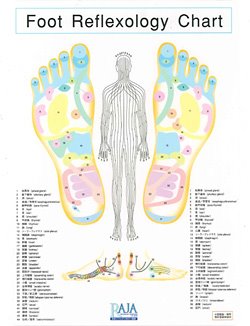© Japan Times, Tuesday, June 6, 2006
http://search.japantimes.co.jp/mail/fs20060606a3.html
From the sole, a new soul
By ERICA ANGYAL
Special to The Japan Times
There's nothing quite like a foot rub, especially after a hard day's work and a long commute home. It's sure to be even more pleasurable if the person working on your feet is a trained practitioner of reflexology, a holistic therapy currently enjoying a boom throughout Japan. Reflexology is an easy way to relieve stress and, arguably, receive other therapeutic benefits, which has no doubt contributed to its popularity -- you can pop into a local salon, take off your shoes, and be out the door in less than 30 minutes, feeling relaxed, refreshed and invigorated.
The human foot, which contains 26 bones and 33 different joints, was once described by Leonardo da Vinci as "a masterpiece of engineering and a work of art." Each foot contains more than 7,000 nerve endings, which connect via the spinal cord and brain to all areas of the anatomy. This is the basis of the practice of reflexology, which uses specific pressure points on the feet to relieve problems elsewhere in the body.
According to reflexology practitioners, the foot is divided into a number of reflex zones, which correspond to different parts of the anatomy. For example, the toes represent the head, including the teeth, mouth, nose, brain, eyes and ears, and the ball of the foot represents the chest area, including the lungs and heart. In essence, the feet are a mirror of the body. Through application of pressure (using the thumbs, index finger and even the knuckles) on these reflexes, reflexology is believed to relieve tension and promote the natural function of the related areas of the body. According to Opal Knowles, president of the Reflexology Association of America, "Reflexology works with all the body's systems to improve the function of the entire system, including organs, glands, and circulation."
Cultures throughout history have utilized various forms of therapeutic foot massage. Foot massage is depicted in relics from ancient Egypt, China, India and Japan. An ancient Egyptian wall painting from the Sixth Dynasty (about 2400 B.C.), found in the tomb of an Egyptian physician, depicts two men massaging the feet and hands of two other men, while Cleopatra is known to have worked on Mark Anthony's feet (circa 60 B.C.). The Brazilians used to perform a technique on the toes known as Brazilian toe massage to balance the energy channels, and the Chinese developed the meridian system, with acupressure points starting or ending on the feet or hands and running through the whole body, which are believed to balance the energy flow, or chi (life force), to all the major organs.

Reflexology's immediate origins, though, lie in a technique known as zone therapy, which was developed by U.S. physician William Fitzgerald in the early 20th century. He discovered that applying pressure on specific parts of the body could have an anesthetic effect on another area of the body. For example, he found that if pressure was applied on the fingers, this could cause a local anesthetic effect from the hand, arm and shoulder right up into the jaw, face and nose. Working on this theory, he divided the body into 10 vertical zones, five on each side, that extended from the head to the fingertips and toes, and from front to back. His conclusion was that pressure on one part of the zone could affect everything else within that zone.
Later, in the 1930s, American physical therapist Eunice Ingham took Fitzgerald's work a step further, by charting the way in which the feet related to the zones, and developing a "map" of which reflex zones in the feet were connected to parts of the anatomy. Ingham, who wrote her first book, "Stories the Feet Can Tell," in 1938, is recognized as the founder of modern foot reflexology.
While shiatsu has a long pedigree in Japan, and Taiwanese foot massage has been popular here for several decades, reflexology was first introduced to Japan just 10 years ago by Keiko Fujita, a savvy former JAL flight attendant who had trained as a reflexologist in England.
On returning to Japan, Fujita and her daughter Maki, who had also studied in England, founded the Reflexology Association of Japan (RAJA) in 1996, followed by the Maki Fujita Reflexology School, and RAJA Inc., a company that manages a chain of reflexology salons, including the Queensway chain, that employ graduates from the school.
According to Sayo Kanagawa, RAJA's public relations director, there are 100 Queensway salons throughout Japan and about 1.8 million people enjoy reflexology treatments in RAJA salons every year. And it's not just the latest women's fad -- men make up about 40 percent of the chain's customers.
There are no laws regulating reflexology practitioners in Japan, and according to reflexology purists, these type of salon treatments are more of a foot massage and less of a real reflexology treatment. If you are seeking a more in-depth experience, you may want to trying visiting one of the private clinics set up by graduates of the British School of Reflexology Japan. In a private clinic, you can expect questions about your medical history and your general health. The reflexologist may take detailed notes about your lifestyle before looking at your feet, and will then make notes about the color, look and feel of your feet and devise a treatment accordingly.
Michelle (Miyuki) Matsuyama, principal of the British School of Reflexology Japan and the Michelle Matsuyama Wholistic Healing School, notes that "every clinic and practitioner has a different philosophy and training, but at the end of the day it's the result that matters the most, and the key is that the person receiving the treatment leaves feeling relaxed and refreshed, with a renewed sense of well-being."
In both salons and private clinics, a reflexology treatment will take place with you seated in a comfortable lounge chair, or lying on a reflexology table, fully clothed with only your shoes and socks removed. Depending on your session plan, the reflexologist will work the feet, or a combination of feet, lower legs and perhaps your hands as well. For the most part, the sensation is pleasant and soothing, but it can be painful at times as the practitioner kneads away at sore spots on your feet.
According to Ann Gillanders, principal of the British School of Reflexology and author of a number of books on reflexology, "the principle of reflexology is to find and work out the sensitive spots in the feet by an alternating pressure of the thumbs and sometimes the index finger on all parts of the foot." Any discomfort is believed to be an indication of congestion or imbalance in a corresponding part of the body.
There are a number of theories as to how reflexology works, yet to date none have been proven. In some circles, reflexology is regarded as a pseudoscience, offering no more benefits than ordinary massage. Robert Todd Carroll of the Skeptics Dictionary, a Web site dedicated to exposing claims that its editors consider unsubstantiated, speculates, "One reason foot massage may be so pleasurable and is associated with significant improvement in mood, is that the area of the brain that connects to the foot is adjacent to the area that connects to the genitals. There may be some neuronal overlapping."
Although scientific evidence is limited, some studies have shown reflexology to be beneficial. One 1993 study in the Journal of Obstetrics and Gynecology found that compared to a placebo treatment, women who received real reflexology treatments reported a significantly greater decrease in PMS symptoms. A further study conducted in Denmark on people with tension or migraine headaches found that 81 percent of the group reported that reflexology sessions reduced or cured their headache pain. And, in yet another recent study, it was found that breast and lung cancer patients experienced less anxiety after reflexology, with the breast cancer patients also reporting a decrease in pain.
Reflexology, done properly, is believed to gently nudge the body toward better functioning by improving lymphatic drainage and venous circulation, stimulating the nerve pathways, and promoting muscle relaxation. Either way, reflexology is used primarily to relieve stress and tension and produce deep therapeutic relaxation.
If you don't have the time or inclination to visit a clinic, there are a plethora of do-it-yourself reflexology books that explain the fundamentals of the technique. You can also select from a wide range of acupressure insoles, sandals, reflexology mats, beaded foot massagers (over which you roll the soles of your feet) and other products designed to stimulate your soles and give you happy, healthy feet. While self-help reflexology is effective, though, nothing really beats a session given by a certified professional to soothe aching soles.
While anecdotal and other evidence indicates that reflexology helps ease a wide variety of chronic problems, including digestive disorders, back pain, migraines and headaches, sinus problems, stress and anxiety, it is not a panacea for all ills. It is certainly not a substitute for medical treatment, but it can be used as a complement to any medical approach or therapy.
For whatever reason, we do know that patients treated with reflexology feel better and enjoy a newfound mental and physical relaxation. It all comes back to those 7,000-plus nerve endings in each foot, and maybe this fact more than any other explains why we feel so much better when our feet are treated. Foot massage is considered a form of relaxation and, to some extent, a luxury. And maybe, given the hectic, pressured lives we lead, that's as good a reason as any for trying it.
The Japan Times
(C) All rights reserved
:::::::::::::::::::::::::::::::::::::::::::::::::::::::::::::::::::::::::::::::::::::::::::::::::::::
極楽庵
GokuRakuAn
だるま資料館
Daruma Museum, Japan
:::::::::::::::::::::::::::::::::::::::::::::::::::::::::::::::::::::::::::::::::::::::::::::::::::::



No comments:
Post a Comment